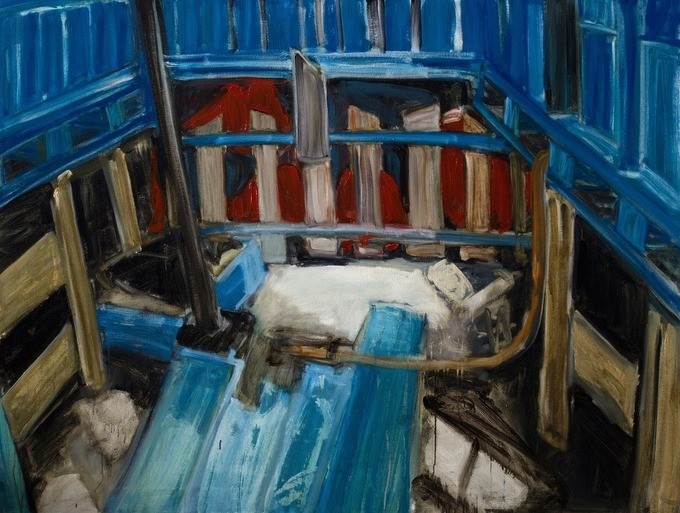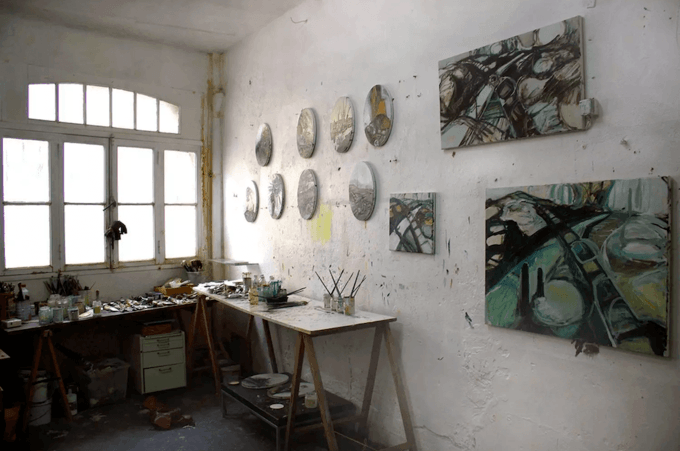Steph Goodger is an award-winning expressionistic painter who creates large-format works on social history, architecture and literature. Recurring themes include conflict zones, theatres of war, the human experience of conflict and its material, social and individual consequences. Steph also explores the impact of trauma and its many manifestations on earth.

How would you describe the art you create?
My paintings evoke spaces and their histories, their atmospheres, and the traces of events. Painting is also an exploration into the immersive world of the imagination. The freedom and the malleability of the painting space is, for me, a reflection of our ability to make mental journeys, through deep interiors, or walking into voids, navigating the unknown, stepping back and forth in time, and negotiating inside and outside.
Oil painting on canvas is my main medium. I do make collages, models, watercolours and am constantly drawing. Although, these are generally the means of arriving at painting solutions, rather than ends in themselves.

Tell us a bit about the inspiration behind your practice
I went to art school at 16 and started painting more or less straight away. There were a couple of excellent teachers there who opened my eyes and my mind to the vast world of painting. I was too immature at the time to have anything to say through painting, but I understood its potential. My engagement with social history came a lot later. I didn’t read back then, or go to lectures, except to sleep. Such a waste!

What/Who are your key influences?
The engineered chaos of Paul Nash’s epic landscapes, as a war artist in World War One. Walter Sickert’s interiors with their strange liminal perspectives on lonely rooms or crowded theatres. These have been my biggest painting influences recently. Before that, Anselm Kiefer's Parsifal Cycle, turning his studio into a mythical realm, Otto Dix’s Der Krieg etchings, and Dada collage. Also, the landscapes of Hokusai for their airy vastness, combined with suspended weighty masses.
Literature and poetry are equally influential to me. Key references come from Dante, Shakespeare, Zola, T. S. Eliot, and Camus. Gaston Bachelard and Walter Benjamin have guided me recently into new territory concerning the phenomenon of space in the imagination. Roland Barthes too, is a crucial reference for photography.

How do you come up with the ideas for your artworks?
I draw a lot from social history and the photographic record to find the spaces and environments that end up in the paintings. Lots of reading and searching through archives happens before touching a brush. I keep notebooks, rather than sketchbooks, where I make small drawings in pen and pencil, like visual note taking.
There is often a fusion between the physical images I find, and images evoked through literature or poetry. These fusions are worked out through the small scrappy drawings in my notebooks, until I begin to imagine the act of painting them.

How has your practice evolved in recent years?
I’ve always worked in series, developing a theme in a variety of ways, until I felt I’d exhausted it. With the recent series Lusitania, however, inspired by the first-class cabins of the ill-fated RMS Lusitania, I am taking more time to explore the spaces, and go deeper into the paintings themselves. There are 21 paintings in the series so far. Each one is a little world-in-itself which links to all the others. There is no overall plan to the series, no beginning, middle and end. Letting things take shape and be what they are, I suppose that is what I’m learning.

What’s an average day like in your studio?
My studio consists of several spaces. There is a large office area, shared with other artists, illustrators, graphic designers, musicians, and an art historian. Then there is the large painting studio I share with one other artist.
I usually head straight for the painting studio. Unless I’m in a phase of writing a proposal, an article, or working on promotion and social media publications, in which case I avoid the painting studio altogether and get straight on with that. Afternoons are roughly the same. I’m also known for taking long naps on the office sofa after lunch.

How do you go about making each work?
Before beginning a painting, I lay out for reference, photocopies of photographs, my notebook sketches, and sometimes watercolours. (Watercolours are another recent development in my practice, since the covid lockdowns.)
I work in oil paint with non-toxic diluents, oils, and mediums. Sometimes I begin by covering the surface with a thin wash of colour, which I then draw into with a small brush laden with dryer, thicker paint; letting it bleed and then wiping back areas with a cloth. Other times, I draw with the brush straight onto the dry texture of the canvas, then add a more liquid wash with a larger brush, to interact with it.
I try to always be the process of discovering the image, seeking it out through the paint, not simply marking it out from sketches and photographs. It’s a matter of expecting the unexpected, remaining in constant negotiation with the paint.

Who are some Rise Art artists with work you're enjoying at the moment?
Artists who I have really enjoyed recently are, amongst others, Jonathan Alibone, Keith Ashcroft, Day Bowman, Robbie Bushe, Michael Coppelov, Michele Fletcher, Paula Macarthur, Enzo Marra, Kate McCrickard and Clare Thatcher.
Are you currently working on any exciting new projects?
I am very excited to have been selected for the Brewers Towner International at the Towner Eastbourne, from 15th October until 22nd January 2023. The theme of the exhibition is Sanctuary. A selection of large paintings from, The Motherland series, will be on display.
I am currently organising exhibitions for the Lusitania series in 2023, working with galleries in Belgium, Liverpool, and London. More information coming soon!
Walking in Two Worlds / Cerdded Mewn Dau Fyd, is an exhibition of 20 artists, last exhibited in August 2022, in Swansea, as part of the BEEP Painting Biennial 2022. We hope to tour the exhibition further in 2023.
Curated by Welsh painter Jonathan Powell and devised by me in collaboration with artist Julian Rowe, Walking in Two Worlds, brings together artists who share interests in prehistoric art, the primitive, the shamanistic and the mysterious.

